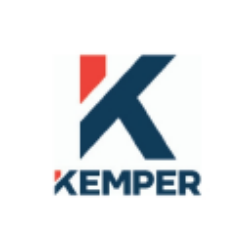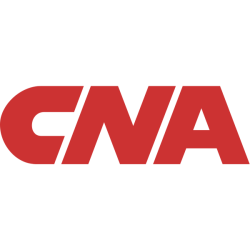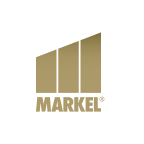WRB

W. R. Berkley Corporation
WRB
(3.0)57,92 USD
4.49% ROA
20.07% ROE
15.03x PER
21.870.265.970,00 USD
36.84% DER
2.55% Yield
11.98% NPM
W. R. Berkley Corporation Stock Analysis
W. R. Berkley Corporation Fundamental Analysis
Fundamental analysis in stock investing is like studying the foundation of a house before buying it. It involves looking at a company's financial health, like its earnings, assets, and debts, to determine if it's a good investment based on its fundamental strength and potential for growth.
| # | Analysis | Rating |
|---|---|---|
| 1 |
ROE
ROE surpassing expectations (19.88%) highlights strong profitability and efficient use of shareholders' equity, making it an appealing investment prospect. |
|
| 2 |
DER
The stock has a low debt to equity ratio (0%), which means it has a small amount of debt compared to the ownership it holds |
|
| 3 |
Revenue Growth
With continuous growth in revenue over the last five years, this company has proven to be a lucrative investment option, showcasing its strong financial performance. |
|
| 4 |
Dividend
The company's consistent dividend payouts over the past five years exemplify its strong commitment to providing shareholders with reliable returns, making it an attractive investment option. |
|
| 5 |
ROA
The stock's ROA (3.8%) shows that it's doing a pretty good job at making money from its assets, making it a solid choice to invest and earn steady profits. |
|
| 6 |
PBV
The stock's PBV ratio (2.73x) indicates a justifiable valuation, presenting a compelling choice for investors seeking reasonable returns. |
|
| 7 |
Assets Growth
Over the past three years, this company's revenue has consistently grown, demonstrating a positive financial trend that makes it an appealing choice. |
|
| 8 |
Buffet Intrinsic Value
The company's stock seems undervalued (806) by Warren Buffett's formula, indicating a promising investment opportunity as its intrinsic value exceeds the market price. |
|
| 9 |
Net Profit Growth
Throughout the last five years, this company's net profit has remained unchanged, indicating a lack of growth and making it a less favorable investment option. |
|
| 10 |
Graham Number
The Graham number of this company suggests that its stock price may be overvalued, indicating a less favorable investment opportunity. |
|
| 11 |
Dividend Growth
The company's dividend growth has remained flat for the past three years, offering no indication of improved returns and making it a less advantageous investment opportunity. |
W. R. Berkley Corporation Technical Analysis
Technical analysis in stock investing is like reading the patterns on a weather map to predict future weather conditions. It involves studying past stock price movements and trading volumes to make predictions about where a stock's price might go next, without necessarily looking at the company's financial health.
| # | Analysis | Recommendation |
|---|---|---|
| 1 | Awesome Oscillator | Hold |
| 2 | MACD | Buy |
| 3 | RSI | Hold |
| 4 | Stoch RSI | Sell |
W. R. Berkley Corporation Price Chart
Financial Statements
Financial statements are like report cards for companies. They show how much money a company makes (income statement), what it owns and owes (balance sheet), and where it spends its money (cash flow statement), helping stock investors understand if a company is healthy and worth investing in.
Income Statements
An income statement for a company is like a scoreboard for its profits and losses. It shows how much money the company made (revenue) and how much it spent to make that money (expenses), helping stock investors see if a company is making a profit or not.
Revenue in stock investing is the total amount of money a company earns from its sales, and it's a key factor that investors consider to assess a company's financial performance and growth potential.
| Year | Revenue | Growth |
|---|---|---|
| 1985 | 214.600.000 | |
| 1986 | 413.400.000 | 48.09% |
| 1987 | 521.000.000 | 20.65% |
| 1988 | 534.200.000 | 2.47% |
| 1989 | 550.800.000 | 3.01% |
| 1990 | 538.100.000 | -2.36% |
| 1991 | 541.300.000 | 0.59% |
| 1992 | 567.200.000 | 4.57% |
| 1993 | 582.600.000 | 2.64% |
| 1994 | 830.800.000 | 29.87% |
| 1995 | 1.021.943.000 | 18.7% |
| 1996 | 1.225.166.000 | 16.59% |
| 1997 | 1.400.310.000 | 12.51% |
| 1998 | 1.582.517.000 | 11.51% |
| 1999 | 1.673.668.000 | 5.45% |
| 2000 | 1.781.287.000 | 6.04% |
| 2001 | 1.941.797.000 | 8.27% |
| 2002 | 2.566.084.000 | 24.33% |
| 2003 | 3.630.108.000 | 29.31% |
| 2004 | 4.512.235.000 | 19.55% |
| 2005 | 4.996.839.000 | 9.7% |
| 2006 | 5.394.831.000 | 7.38% |
| 2007 | 5.553.639.000 | 2.86% |
| 2008 | 4.708.808.000 | -17.94% |
| 2009 | 4.431.178.000 | -6.27% |
| 2010 | 4.724.069.000 | 6.2% |
| 2011 | 5.155.984.000 | 8.38% |
| 2012 | 5.576.441.000 | 7.54% |
| 2013 | 6.011.031.000 | 7.23% |
| 2014 | 6.718.933.000 | 10.54% |
| 2015 | 6.784.955.000 | 0.97% |
| 2016 | 7.666.088.000 | 11.49% |
| 2017 | 7.669.497.000 | 0.04% |
| 2018 | 7.718.718.000 | 0.64% |
| 2019 | 7.932.911.000 | 2.7% |
| 2020 | 8.098.562.000 | 2.05% |
| 2021 | 9.481.191.000 | 14.58% |
| 2022 | 11.217.429.000 | 15.48% |
| 2023 | 12.212.544.000 | 8.15% |
| 2023 | 12.142.938.000 | -0.57% |
| 2024 | 13.246.160.000 | 8.33% |
Research and Development Expenses are the costs a company incurs to create and improve its products or services, which can be important for investors to evaluate a company's innovation and potential for future growth.
| Year | Research and Development Expenses | Growth |
|---|---|---|
| 1985 | 0 | |
| 1986 | 0 | 0% |
| 1987 | 0 | 0% |
| 1988 | 0 | 0% |
| 1989 | 0 | 0% |
| 1990 | 0 | 0% |
| 1991 | 0 | 0% |
| 1992 | 0 | 0% |
| 1993 | 0 | 0% |
| 1994 | 0 | 0% |
| 1995 | 0 | 0% |
| 1996 | 0 | 0% |
| 1997 | 0 | 0% |
| 1998 | 0 | 0% |
| 1999 | 0 | 0% |
| 2000 | 0 | 0% |
| 2001 | 0 | 0% |
| 2002 | 0 | 0% |
| 2003 | 0 | 0% |
| 2004 | 0 | 0% |
| 2005 | 0 | 0% |
| 2006 | 0 | 0% |
| 2007 | 0 | 0% |
| 2008 | 0 | 0% |
| 2009 | 0 | 0% |
| 2010 | 0 | 0% |
| 2011 | 0 | 0% |
| 2012 | 0 | 0% |
| 2013 | 0 | 0% |
| 2014 | 0 | 0% |
| 2015 | 0 | 0% |
| 2016 | 0 | 0% |
| 2017 | 0 | 0% |
| 2018 | 0 | 0% |
| 2019 | 0 | 0% |
| 2020 | 0 | 0% |
| 2021 | 0 | 0% |
| 2022 | 0 | 0% |
| 2023 | 0 | 0% |
| 2023 | 0 | 0% |
| 2024 | 0 | 0% |
General and Administrative Expenses are the costs a company incurs to run its day-to-day operations, such as office rent, salaries, and utilities, which investors consider to understand a company's overall efficiency and management effectiveness.
| Year | General and Administrative Expenses | Growth |
|---|---|---|
| 1985 | 0 | |
| 1986 | 0 | 0% |
| 1987 | 0 | 0% |
| 1988 | 0 | 0% |
| 1989 | 0 | 0% |
| 1990 | 0 | 0% |
| 1991 | 0 | 0% |
| 1992 | 0 | 0% |
| 1993 | 0 | 0% |
| 1994 | 0 | 0% |
| 1995 | 0 | 0% |
| 1996 | 0 | 0% |
| 1997 | 0 | 0% |
| 1998 | 0 | 0% |
| 1999 | 0 | 0% |
| 2000 | 0 | 0% |
| 2001 | 0 | 0% |
| 2002 | 0 | 0% |
| 2003 | 0 | 0% |
| 2004 | 0 | 0% |
| 2005 | 0 | 0% |
| 2006 | 0 | 0% |
| 2007 | 0 | 0% |
| 2008 | 0 | 0% |
| 2009 | 0 | 0% |
| 2010 | 0 | 0% |
| 2011 | 0 | 0% |
| 2012 | 0 | 0% |
| 2013 | 0 | 0% |
| 2014 | 0 | 0% |
| 2015 | 0 | 0% |
| 2016 | 0 | 0% |
| 2017 | 0 | 0% |
| 2018 | 0 | 0% |
| 2019 | 0 | 0% |
| 2020 | 0 | 0% |
| 2021 | 0 | 0% |
| 2022 | 0 | 0% |
| 2023 | 0 | 0% |
| 2023 | 0 | 0% |
| 2024 | 0 | 0% |
EBITDA stands for Earnings Before Interest, Taxes, Depreciation, and Amortization. It is a measure that helps stock investors analyze a company's profitability by looking at its earnings without considering certain expenses. This helps to get a clearer picture of the company's financial performance and its ability to generate cash flow.
| Year | EBITDA | Growth |
|---|---|---|
| 1985 | 0 | |
| 1986 | 0 | 0% |
| 1987 | 0 | 0% |
| 1988 | 0 | 0% |
| 1989 | 0 | 0% |
| 1990 | 0 | 0% |
| 1991 | 0 | 0% |
| 1992 | 29.300.000 | 100% |
| 1993 | 35.100.000 | 16.52% |
| 1994 | 76.100.000 | 53.88% |
| 1995 | 120.931.000 | 37.07% |
| 1996 | 155.918.000 | 22.44% |
| 1997 | 60.800.000 | -156.44% |
| 1998 | 135.702.000 | 55.2% |
| 1999 | -5.415.000 | 2606.04% |
| 2000 | 107.985.000 | 105.01% |
| 2001 | -88.050.000 | 222.64% |
| 2002 | 322.162.000 | 127.33% |
| 2003 | 562.903.000 | 42.77% |
| 2004 | 759.970.000 | 25.93% |
| 2005 | 882.809.000 | 13.91% |
| 2006 | 1.146.841.000 | 23.02% |
| 2007 | 1.220.327.000 | 6.02% |
| 2008 | 494.898.000 | -146.58% |
| 2009 | 549.094.000 | 9.87% |
| 2010 | 793.141.000 | 30.77% |
| 2011 | 713.610.000 | -11.14% |
| 2012 | 931.649.000 | 23.4% |
| 2013 | 925.155.000 | -0.7% |
| 2014 | 1.169.206.000 | 20.87% |
| 2015 | 948.115.000 | -23.32% |
| 2016 | 1.123.385.000 | 15.6% |
| 2017 | 1.033.023.000 | -8.75% |
| 2018 | 1.100.387.000 | 6.12% |
| 2019 | 1.119.716.000 | 1.73% |
| 2020 | 990.404.000 | -13.06% |
| 2021 | 1.559.767.000 | 36.5% |
| 2022 | 1.905.927.000 | 18.16% |
| 2023 | 1.131.444.000 | -68.45% |
| 2023 | 1.861.001.000 | 39.2% |
| 2024 | 96.000 | -1938442.71% |
Gross profit is the money a company makes from selling its products or services after subtracting the cost of producing or providing them, and it is an important measure for investors to understand a company's profitability.
| Year | Gross Profit | Growth |
|---|---|---|
| 1985 | 214.600.000 | |
| 1986 | 413.400.000 | 48.09% |
| 1987 | 521.000.000 | 20.65% |
| 1988 | 534.200.000 | 2.47% |
| 1989 | 550.800.000 | 3.01% |
| 1990 | 538.100.000 | -2.36% |
| 1991 | 541.300.000 | 0.59% |
| 1992 | 567.200.000 | 4.57% |
| 1993 | 582.600.000 | 2.64% |
| 1994 | 830.800.000 | 29.87% |
| 1995 | 1.021.943.000 | 18.7% |
| 1996 | 1.225.166.000 | 16.59% |
| 1997 | 1.400.310.000 | 12.51% |
| 1998 | 1.582.517.000 | 11.51% |
| 1999 | 1.673.668.000 | 5.45% |
| 2000 | 1.781.287.000 | 6.04% |
| 2001 | 1.941.797.000 | 8.27% |
| 2002 | 2.566.084.000 | 24.33% |
| 2003 | 3.630.108.000 | 29.31% |
| 2004 | 4.512.235.000 | 19.55% |
| 2005 | 4.996.839.000 | 9.7% |
| 2006 | 5.394.831.000 | 7.38% |
| 2007 | 5.553.639.000 | 2.86% |
| 2008 | 4.708.808.000 | -17.94% |
| 2009 | 4.431.178.000 | -6.27% |
| 2010 | 4.724.069.000 | 6.2% |
| 2011 | 3.534.655.000 | -33.65% |
| 2012 | 3.776.818.000 | 6.41% |
| 2013 | 4.010.347.000 | 5.82% |
| 2014 | 4.561.477.000 | 12.08% |
| 2015 | 4.495.205.000 | -1.47% |
| 2016 | 5.270.469.000 | 14.71% |
| 2017 | 5.232.565.000 | -0.72% |
| 2018 | 5.335.497.000 | 1.93% |
| 2019 | 5.570.829.000 | 4.22% |
| 2020 | 5.708.170.000 | 2.41% |
| 2021 | 6.881.921.000 | 17.06% |
| 2022 | 8.255.924.000 | 16.64% |
| 2023 | 8.977.868.000 | 8.04% |
| 2023 | 8.779.002.000 | -2.27% |
| 2024 | 9.674.420.000 | 9.26% |
Net income in stock investing is like the money a company actually gets to keep as profit after paying all its bills, and it's an important measure to understand how well a company is doing financially.
| Year | Net Profit | Growth |
|---|---|---|
| 1985 | 6.900.000 | |
| 1986 | 29.400.000 | 76.53% |
| 1987 | 54.100.000 | 45.66% |
| 1988 | 59.400.000 | 8.92% |
| 1989 | 55.800.000 | -6.45% |
| 1990 | 36.100.000 | -54.57% |
| 1991 | 46.600.000 | 22.53% |
| 1992 | 52.400.000 | 11.07% |
| 1993 | 51.600.000 | -1.55% |
| 1994 | 35.100.000 | -47.01% |
| 1995 | 60.882.000 | 42.35% |
| 1996 | 90.263.000 | 32.55% |
| 1997 | 99.047.000 | 8.87% |
| 1998 | 58.760.000 | -68.56% |
| 1999 | -34.048.000 | 272.58% |
| 2000 | 36.238.000 | 193.96% |
| 2001 | -91.546.000 | 139.58% |
| 2002 | 175.045.000 | 152.3% |
| 2003 | 337.220.000 | 48.09% |
| 2004 | 438.105.000 | 23.03% |
| 2005 | 544.892.000 | 19.6% |
| 2006 | 699.518.000 | 22.1% |
| 2007 | 743.646.000 | 5.93% |
| 2008 | 281.141.000 | -164.51% |
| 2009 | 309.057.000 | 9.03% |
| 2010 | 449.287.000 | 31.21% |
| 2011 | 394.803.000 | -13.8% |
| 2012 | 510.592.000 | 22.68% |
| 2013 | 499.925.000 | -2.13% |
| 2014 | 648.884.000 | 22.96% |
| 2015 | 503.694.000 | -28.83% |
| 2016 | 601.916.000 | 16.32% |
| 2017 | 549.094.000 | -9.62% |
| 2018 | 640.749.000 | 14.3% |
| 2019 | 681.944.000 | 6.04% |
| 2020 | 530.670.000 | -28.51% |
| 2021 | 1.022.490.000 | 48.1% |
| 2022 | 1.381.062.000 | 25.96% |
| 2023 | 1.334.344.000 | -3.5% |
| 2023 | 1.381.359.000 | 3.4% |
| 2024 | 1.487.636.000 | 7.14% |
EPS, or earnings per share, is a measure that shows how much profit a company has earned for each outstanding share of its stock, and it is important for stock investors as it helps understand the profitability of a company and compare it with other companies in the market.
| Year | Earning per Share (EPS) | Growth |
|---|---|---|
| 1985 | 0 | |
| 1986 | 0 | 0% |
| 1987 | 0 | 0% |
| 1988 | 0 | 0% |
| 1989 | 0 | 0% |
| 1990 | 0 | 0% |
| 1991 | 0 | 0% |
| 1992 | 0 | 0% |
| 1993 | 0 | 0% |
| 1994 | 0 | 0% |
| 1995 | 0 | 0% |
| 1996 | 0 | 0% |
| 1997 | 0 | 0% |
| 1998 | 0 | 0% |
| 1999 | 0 | 0% |
| 2000 | 0 | 0% |
| 2001 | 0 | 0% |
| 2002 | 0 | 0% |
| 2003 | 1 | 0% |
| 2004 | 1 | 100% |
| 2005 | 1 | 0% |
| 2006 | 2 | 0% |
| 2007 | 2 | 0% |
| 2008 | 1 | 0% |
| 2009 | 1 | 0% |
| 2010 | 1 | 100% |
| 2011 | 1 | 0% |
| 2012 | 2 | 0% |
| 2013 | 1 | 0% |
| 2014 | 2 | 0% |
| 2015 | 1 | 0% |
| 2016 | 1 | 0% |
| 2017 | 1 | 0% |
| 2018 | 1 | 0% |
| 2019 | 2 | 0% |
| 2020 | 1 | 0% |
| 2021 | 2 | 50% |
| 2022 | 3 | 33.33% |
| 2023 | 5 | 25% |
| 2023 | 3 | -33.33% |
| 2024 | 4 | 0% |
Cashflow Statements
Cashflow statements show the movement of money in and out of a company, helping stock investors understand how much money a company makes and spends. By examining cashflow statements, investors can assess if a company is generating enough cash to pay its bills, invest in growth, and provide returns to stockholders.
Free cash flow is the leftover cash that a company generates after covering its operating expenses and capital expenditures, which is important for stock investors as it shows how much money a company has available to invest in growth, pay dividends, or reduce debt.
| Year | Free Cashflow | Growth |
|---|---|---|
| 1989 | 132.300.000 | |
| 1990 | 112.800.000 | -17.29% |
| 1991 | 113.800.000 | 0.88% |
| 1992 | 40.800.000 | -178.92% |
| 1993 | 143.300.000 | 71.53% |
| 1994 | 117.300.000 | -22.17% |
| 1995 | 159.281.000 | 26.36% |
| 1996 | 106.873.000 | -49.04% |
| 1997 | 281.090.000 | 61.98% |
| 1998 | 192.536.000 | -45.99% |
| 1999 | 40.942.000 | -370.27% |
| 2000 | -20.804.000 | 296.8% |
| 2001 | 129.868.000 | 116.02% |
| 2002 | 922.540.000 | 85.92% |
| 2003 | 1.369.868.000 | 32.65% |
| 2004 | 1.577.818.000 | 13.18% |
| 2005 | 1.687.475.000 | 6.5% |
| 2006 | 1.521.421.000 | -10.91% |
| 2007 | 1.448.659.000 | -5.02% |
| 2008 | 1.474.013.000 | 1.72% |
| 2009 | 285.599.000 | -416.11% |
| 2010 | 401.711.000 | 28.9% |
| 2011 | 624.959.000 | 35.72% |
| 2012 | 634.902.000 | 1.57% |
| 2013 | 756.648.000 | 16.09% |
| 2014 | 692.889.000 | -9.2% |
| 2015 | 817.742.000 | 15.27% |
| 2016 | 797.547.000 | -2.53% |
| 2017 | 595.164.000 | -34% |
| 2018 | 570.339.000 | -4.35% |
| 2019 | 1.083.336.000 | 47.35% |
| 2020 | 1.578.515.000 | 31.37% |
| 2021 | 2.117.353.000 | 25.45% |
| 2022 | 2.515.920.000 | 15.84% |
| 2023 | 0 | 0% |
| 2023 | 2.930.371.000 | 100% |
| 2024 | 791.391.000 | -270.28% |
Operating cash flow represents the cash generated or consumed by a company's day-to-day operations, excluding external investing or financing activities, and is crucial for stock investors as it shows how much cash a company is generating from its core business operations.
| Year | Operating Cashflow | Growth |
|---|---|---|
| 1989 | 132.300.000 | |
| 1990 | 112.800.000 | -17.29% |
| 1991 | 119.400.000 | 5.53% |
| 1992 | 47.500.000 | -151.37% |
| 1993 | 153.300.000 | 69.02% |
| 1994 | 117.300.000 | -30.69% |
| 1995 | 159.281.000 | 26.36% |
| 1996 | 153.856.000 | -3.53% |
| 1997 | 298.988.000 | 48.54% |
| 1998 | 219.703.000 | -36.09% |
| 1999 | 49.069.000 | -347.74% |
| 2000 | -13.275.000 | 469.63% |
| 2001 | 151.944.000 | 108.74% |
| 2002 | 959.110.000 | 84.16% |
| 2003 | 1.398.183.000 | 31.4% |
| 2004 | 1.619.689.000 | 13.68% |
| 2005 | 1.719.751.000 | 5.82% |
| 2006 | 1.564.014.000 | -9.96% |
| 2007 | 1.479.767.000 | -5.69% |
| 2008 | 1.552.960.000 | 4.71% |
| 2009 | 316.054.000 | -391.36% |
| 2010 | 451.316.000 | 29.97% |
| 2011 | 670.279.000 | 32.67% |
| 2012 | 675.458.000 | 0.77% |
| 2013 | 819.798.000 | 17.61% |
| 2014 | 734.847.000 | -11.56% |
| 2015 | 881.304.000 | 16.62% |
| 2016 | 848.376.000 | -3.88% |
| 2017 | 710.883.000 | -19.34% |
| 2018 | 620.199.000 | -14.62% |
| 2019 | 1.143.793.000 | 45.78% |
| 2020 | 1.616.686.000 | 29.25% |
| 2021 | 2.183.987.000 | 25.98% |
| 2022 | 2.568.604.000 | 14.97% |
| 2023 | 0 | 0% |
| 2023 | 2.983.451.000 | 100% |
| 2024 | 815.524.000 | -265.83% |
Capex, short for capital expenditures, refers to the money a company spends on acquiring or upgrading tangible assets like buildings, equipment, or technology, which is important for stock investors as it indicates how much a company is investing in its infrastructure to support future growth and profitability.
| Year | Capital Expenditure | Growth |
|---|---|---|
| 1989 | 0 | |
| 1990 | 0 | 0% |
| 1991 | 5.600.000 | 100% |
| 1992 | 6.700.000 | 16.42% |
| 1993 | 10.000.000 | 33% |
| 1994 | 0 | 0% |
| 1995 | 0 | 0% |
| 1996 | 46.983.000 | 100% |
| 1997 | 17.898.000 | -162.5% |
| 1998 | 27.167.000 | 34.12% |
| 1999 | 8.127.000 | -234.28% |
| 2000 | 7.529.000 | -7.94% |
| 2001 | 22.076.000 | 65.9% |
| 2002 | 36.570.000 | 39.63% |
| 2003 | 28.315.000 | -29.15% |
| 2004 | 41.871.000 | 32.38% |
| 2005 | 32.276.000 | -29.73% |
| 2006 | 42.593.000 | 24.22% |
| 2007 | 31.108.000 | -36.92% |
| 2008 | 78.947.000 | 60.6% |
| 2009 | 30.455.000 | -159.23% |
| 2010 | 49.605.000 | 38.6% |
| 2011 | 45.320.000 | -9.45% |
| 2012 | 40.556.000 | -11.75% |
| 2013 | 63.150.000 | 35.78% |
| 2014 | 41.958.000 | -50.51% |
| 2015 | 63.562.000 | 33.99% |
| 2016 | 50.829.000 | -25.05% |
| 2017 | 115.719.000 | 56.08% |
| 2018 | 49.860.000 | -132.09% |
| 2019 | 60.457.000 | 17.53% |
| 2020 | 38.171.000 | -58.38% |
| 2021 | 66.634.000 | 42.72% |
| 2022 | 52.684.000 | -26.48% |
| 2023 | 0 | 0% |
| 2023 | 53.080.000 | 100% |
| 2024 | 24.133.000 | -119.95% |
Balance Sheet
Balance sheets provide a snapshot of a company's financial health and its assets (such as cash, inventory, and property) and liabilities (like debts and obligations) at a specific point in time. For stock investors, balance sheets help assess the company's overall worth and evaluate its ability to meet financial obligations and support future growth.
Equity refers to the ownership interest or stake that shareholders have in a company, representing their claim on its assets and earnings after all debts and liabilities are paid.
| Year | Equity | Growth |
|---|---|---|
| 1985 | 77.000.000 | |
| 1986 | 226.100.000 | 65.94% |
| 1987 | 271.500.000 | 16.72% |
| 1988 | 302.500.000 | 10.25% |
| 1989 | 329.800.000 | 8.28% |
| 1990 | 350.100.000 | 5.8% |
| 1991 | 421.700.000 | 16.98% |
| 1992 | 474.400.000 | 11.11% |
| 1993 | 526.300.000 | 9.86% |
| 1994 | 658.400.000 | 20.06% |
| 1995 | 939.614.000 | 29.93% |
| 1996 | 892.062.000 | -5.33% |
| 1997 | 971.649.000 | 8.19% |
| 1998 | 885.060.000 | -9.78% |
| 1999 | 622.053.000 | -42.28% |
| 2000 | 712.773.000 | 12.73% |
| 2001 | 955.891.000 | 25.43% |
| 2002 | 1.353.848.000 | 29.39% |
| 2003 | 1.720.710.000 | 21.32% |
| 2004 | 2.155.853.000 | 20.18% |
| 2005 | 2.588.391.000 | 16.71% |
| 2006 | 3.365.774.000 | 23.1% |
| 2007 | 3.605.271.000 | 6.64% |
| 2008 | 3.051.680.000 | -18.14% |
| 2009 | 3.601.946.000 | 15.28% |
| 2010 | 3.709.856.000 | 2.91% |
| 2011 | 4.015.952.000 | 7.62% |
| 2012 | 4.335.466.000 | 7.37% |
| 2013 | 4.369.394.000 | 0.78% |
| 2014 | 4.624.134.000 | 5.51% |
| 2015 | 4.633.208.000 | 0.2% |
| 2016 | 5.081.134.000 | 8.82% |
| 2017 | 5.451.163.000 | 6.79% |
| 2018 | 5.479.798.000 | 0.52% |
| 2019 | 6.118.342.000 | 10.44% |
| 2020 | 6.325.797.000 | 3.28% |
| 2021 | 6.667.730.000 | 5.13% |
| 2022 | 6.768.161.000 | 1.48% |
| 2023 | 6.929.909.000 | 2.33% |
| 2023 | 7.469.237.000 | 7.22% |
| 2024 | 7.787.051.000 | 4.08% |
Assets represent the valuable resources that a company owns, such as cash, inventory, property, and equipment, and understanding a company's assets helps investors assess its value and potential for generating future profits.
| Year | Assets | Growth |
|---|---|---|
| 1985 | 500.000.000 | |
| 1986 | 873.900.000 | 42.79% |
| 1987 | 1.064.900.000 | 17.94% |
| 1988 | 1.231.600.000 | 13.54% |
| 1989 | 1.355.700.000 | 9.15% |
| 1990 | 1.408.300.000 | 3.73% |
| 1991 | 1.526.000.000 | 7.71% |
| 1992 | 1.712.300.000 | 10.88% |
| 1993 | 2.156.500.000 | 20.6% |
| 1994 | 3.582.300.000 | 39.8% |
| 1995 | 3.618.684.000 | 1.01% |
| 1996 | 4.073.264.000 | 11.16% |
| 1997 | 4.599.284.000 | 11.44% |
| 1998 | 4.983.431.000 | 7.71% |
| 1999 | 4.784.791.000 | -4.15% |
| 2000 | 5.022.070.000 | 4.72% |
| 2001 | 5.633.509.000 | 10.85% |
| 2002 | 7.031.323.000 | 19.88% |
| 2003 | 9.334.685.000 | 24.68% |
| 2004 | 11.451.033.000 | 18.48% |
| 2005 | 13.896.287.000 | 17.6% |
| 2006 | 15.656.489.000 | 11.24% |
| 2007 | 16.832.170.000 | 6.98% |
| 2008 | 16.121.158.000 | -4.41% |
| 2009 | 17.328.596.000 | 6.97% |
| 2010 | 17.528.547.000 | 1.14% |
| 2011 | 18.487.731.000 | 5.19% |
| 2012 | 24.491.362.000 | 24.51% |
| 2013 | 24.921.190.000 | 1.72% |
| 2014 | 26.340.825.000 | 5.39% |
| 2015 | 26.364.175.000 | 0.09% |
| 2016 | 28.445.977.000 | 7.32% |
| 2017 | 29.763.793.000 | 4.43% |
| 2018 | 30.375.775.000 | 2.01% |
| 2019 | 32.761.770.000 | 7.28% |
| 2020 | 34.932.710.000 | 6.21% |
| 2021 | 32.101.133.000 | -8.82% |
| 2022 | 33.880.928.000 | 5.25% |
| 2023 | 36.111.348.000 | 6.18% |
| 2023 | 32.908.561.000 | -9.73% |
| 2024 | 34.593.169.000 | 4.87% |
Liabilities refer to the financial obligations or debts that a company owes to creditors or external parties, and understanding a company's liabilities is important for investors as it helps assess the company's financial risk and ability to meet its obligations.
| Year | Liabilities | Growth |
|---|---|---|
| 1985 | 423.000.000 | |
| 1986 | 647.800.000 | 34.7% |
| 1987 | 793.400.000 | 18.35% |
| 1988 | 929.100.000 | 14.61% |
| 1989 | 1.025.900.000 | 9.44% |
| 1990 | 1.058.200.000 | 3.05% |
| 1991 | 1.104.300.000 | 4.17% |
| 1992 | 1.237.900.000 | 10.79% |
| 1993 | 1.630.200.000 | 24.06% |
| 1994 | 2.923.900.000 | 44.25% |
| 1995 | 2.679.070.000 | -9.14% |
| 1996 | 3.181.202.000 | 15.78% |
| 1997 | 3.627.635.000 | 12.31% |
| 1998 | 4.098.371.000 | 11.49% |
| 1999 | 4.162.738.000 | 1.55% |
| 2000 | 4.309.297.000 | 3.4% |
| 2001 | 4.677.618.000 | 7.87% |
| 2002 | 5.677.475.000 | 17.61% |
| 2003 | 7.613.975.000 | 25.43% |
| 2004 | 9.295.180.000 | 18.09% |
| 2005 | 11.307.896.000 | 17.8% |
| 2006 | 12.290.715.000 | 8% |
| 2007 | 13.226.899.000 | 7.08% |
| 2008 | 13.069.478.000 | -1.2% |
| 2009 | 13.726.650.000 | 4.79% |
| 2010 | 13.818.691.000 | 0.67% |
| 2011 | 14.471.779.000 | 4.51% |
| 2012 | 20.155.896.000 | 28.2% |
| 2013 | 20.551.796.000 | 1.93% |
| 2014 | 21.716.691.000 | 5.36% |
| 2015 | 21.730.967.000 | 0.07% |
| 2016 | 23.364.843.000 | 6.99% |
| 2017 | 24.312.630.000 | 3.9% |
| 2018 | 24.895.977.000 | 2.34% |
| 2019 | 26.643.428.000 | 6.56% |
| 2020 | 28.606.913.000 | 6.86% |
| 2021 | 25.433.403.000 | -12.48% |
| 2022 | 27.112.767.000 | 6.19% |
| 2023 | 0 | 0% |
| 2023 | 25.439.324.000 | 100% |
| 2024 | 26.806.118.000 | 5.1% |
W. R. Berkley Corporation Financial Ratio (TTM)
Valuation Metrics
- Revenue per Share
- 31.72
- Net Income per Share
- 3.82
- Price to Earning Ratio
- 15.03x
- Price To Sales Ratio
- 1.71x
- POCF Ratio
- 6.91
- PFCF Ratio
- 6.71
- Price to Book Ratio
- 2.99
- EV to Sales
- 1.82
- EV Over EBITDA
- 88.77
- EV to Operating CashFlow
- 6.94
- EV to FreeCashFlow
- 7.17
- Earnings Yield
- 0.07
- FreeCashFlow Yield
- 0.15
- Market Cap
- 21,87 Bil.
- Enterprise Value
- 23,36 Bil.
- Graham Number
- 40.67
- Graham NetNet
- -46.57
Income Statement Metrics
- Net Income per Share
- 3.82
- Income Quality
- 2.18
- ROE
- 0.21
- Return On Assets
- 0.04
- Return On Capital Employed
- 0.05
- Net Income per EBT
- 0.77
- EBT Per Ebit
- 1.91
- Ebit per Revenue
- 0.08
- Effective Tax Rate
- 0.23
Margins
- Sales, General, & Administrative to Revenue
- 0
- Research & Developement to Revenue
- 0
- Stock Based Compensation to Revenue
- 0
- Gross Profit Margin
- 0.72
- Operating Profit Margin
- 0.08
- Pretax Profit Margin
- 0.15
- Net Profit Margin
- 0.12
Dividends
- Dividend Yield
- 0.03
- Dividend Yield %
- 2.55
- Payout Ratio
- 0.32
- Dividend Per Share
- 1.46
Operating Metrics
- Operating Cashflow per Share
- 8.32
- Free CashFlow per Share
- 8.06
- Capex to Operating CashFlow
- 0.03
- Capex to Revenue
- 0.01
- Capex to Depreciation
- -0.61
- Return on Invested Capital
- 0.06
- Return on Tangible Assets
- 0.04
- Days Sales Outstanding
- 204.77
- Days Payables Outstanding
- 76.69
- Days of Inventory on Hand
- -184.85
- Receivables Turnover
- 1.78
- Payables Turnover
- 4.76
- Inventory Turnover
- -1.97
- Capex per Share
- 0.26
Balance Sheet
- Cash per Share
- 8,57
- Book Value per Share
- 19,26
- Tangible Book Value per Share
- 18.81
- Shareholders Equity per Share
- 19.23
- Interest Debt per Share
- 7.4
- Debt to Equity
- 0.37
- Debt to Assets
- 0.08
- Net Debt to EBITDA
- 5.66
- Current Ratio
- 0.42
- Tangible Asset Value
- 7,60 Bil.
- Net Current Asset Value
- -19,64 Bil.
- Invested Capital
- -8889686000
- Working Capital
- -9,74 Bil.
- Intangibles to Total Assets
- 0.01
- Average Receivables
- 7,07 Bil.
- Average Payables
- 0,71 Bil.
- Average Inventory
- -1613118000
- Debt to Market Cap
- 0.13
Dividends
Dividends in stock investing are like rewards that companies give to their shareholders. They are a portion of the company's profits distributed to investors, typically in the form of cash payments, as a way for them to share in the company's success.
| Year | Dividends | Growth |
|---|---|---|
| 1985 | 0 | |
| 1986 | 0 | 0% |
| 1987 | 0 | 0% |
| 1988 | 0 | 0% |
| 1989 | 0 | 0% |
| 1990 | 0 | 0% |
| 1991 | 0 | 0% |
| 1992 | 0 | 0% |
| 1993 | 0 | 0% |
| 1994 | 0 | 0% |
| 1995 | 0 | 0% |
| 1996 | 1 | 0% |
| 1997 | 1 | 0% |
| 1998 | 0 | 0% |
| 1999 | 1 | 0% |
| 2000 | 1 | 0% |
| 2001 | 1 | 0% |
| 2002 | 0 | 0% |
| 2003 | 0 | 0% |
| 2004 | 0 | 0% |
| 2005 | 0 | 0% |
| 2006 | 0 | 0% |
| 2007 | 0 | 0% |
| 2008 | 0 | 0% |
| 2009 | 0 | 0% |
| 2010 | 0 | 0% |
| 2011 | 0 | 0% |
| 2012 | 1 | 100% |
| 2013 | 0 | 0% |
| 2014 | 1 | 100% |
| 2015 | 0 | 0% |
| 2016 | 2 | 100% |
| 2017 | 1 | 0% |
| 2018 | 2 | 0% |
| 2019 | 2 | 0% |
| 2020 | 0 | 0% |
| 2021 | 2 | 100% |
| 2022 | 1 | 0% |
| 2023 | 2 | 100% |
| 2024 | 1 | 0% |
W. R. Berkley Corporation Profile
About W. R. Berkley Corporation
W. R. Berkley Corporation, an insurance holding company, operates as a commercial lines writer in the United States and internationally. It operates in two segments, Insurance and Reinsurance & Monoline Excess. The Insurance segment underwrites commercial insurance business, including premises operations, commercial automobile, property, products liability, and general and professional liability lines. It also provides workers' compensation insurance products; accident and health insurance and reinsurance products; insurance for commercial risks; specialty environmental products for contractors, consultants, and property owners and facilities operators; specialized insurance coverages for fine arts and jewelry exposures; umbrella and excess liability coverage products; and liquor liability and inland marine coverage for small to medium-sized insureds. In addition, this segment offers directors and officers, and surety risk products, as well as products for technology, and life sciences and travel industries; cyber risk solutions; casualty, group life, and crime and fidelity related insurance products; personal lines insurance solutions, including home, condo/co-op, auto, and collectibles; automobile, law enforcement, public officials and educator's legal, and employment practices liability, as well as incidental medical insurance products; and at-risk and alternative risk insurance program management services. The Reinsurance & Monoline Excess segment provides other insurance companies and self-insureds with assistance in managing their net risk through reinsurance on a portfolio basis through treaty reinsurance or on an individual basis through facultative reinsurance. W. R. Berkley Corporation was founded in 1967 and is based in Greenwich, Connecticut.
- CEO
- Mr. William Robert Berkley Jr.
- Employee
- 8.329
- Address
-
475 Steamboat Road
Greenwich, 06830
W. R. Berkley Corporation Executives & BODs
| # | Name | Age |
|---|---|---|
| 1 |
Mr. William Robert Berkley Executive Chairman of the Board |
70 |
| 2 |
Mr. William Robert Berkley Jr. President, Chief Executive Officer & Director |
70 |
| 3 |
Mr. A. Scott Mansolillo Senior Vice President & Chief Compliance Officer |
70 |
| 4 |
Mr. Liberatore John Iannarone Senior Vice President & General Counsel |
70 |
| 5 |
Ms. Karen A. Horvath Vice President of External Financial Communications |
70 |
| 6 |
Mr. Jonathan M. Levine Vice President & Chief Marketing Officer |
70 |
| 7 |
Ms. Carol Josephine LaPunzina Senior Vice President of Human Resources |
70 |
| 8 |
Mr. Richard Mark Baio Executive Vice President & Chief Financial Officer |
70 |
| 9 |
Mr. James Gerald Shiel Executive Vice President of Investments |
70 |
| 10 |
Ms. Lucille T. Sgaglione Executive Vice President |
70 |













